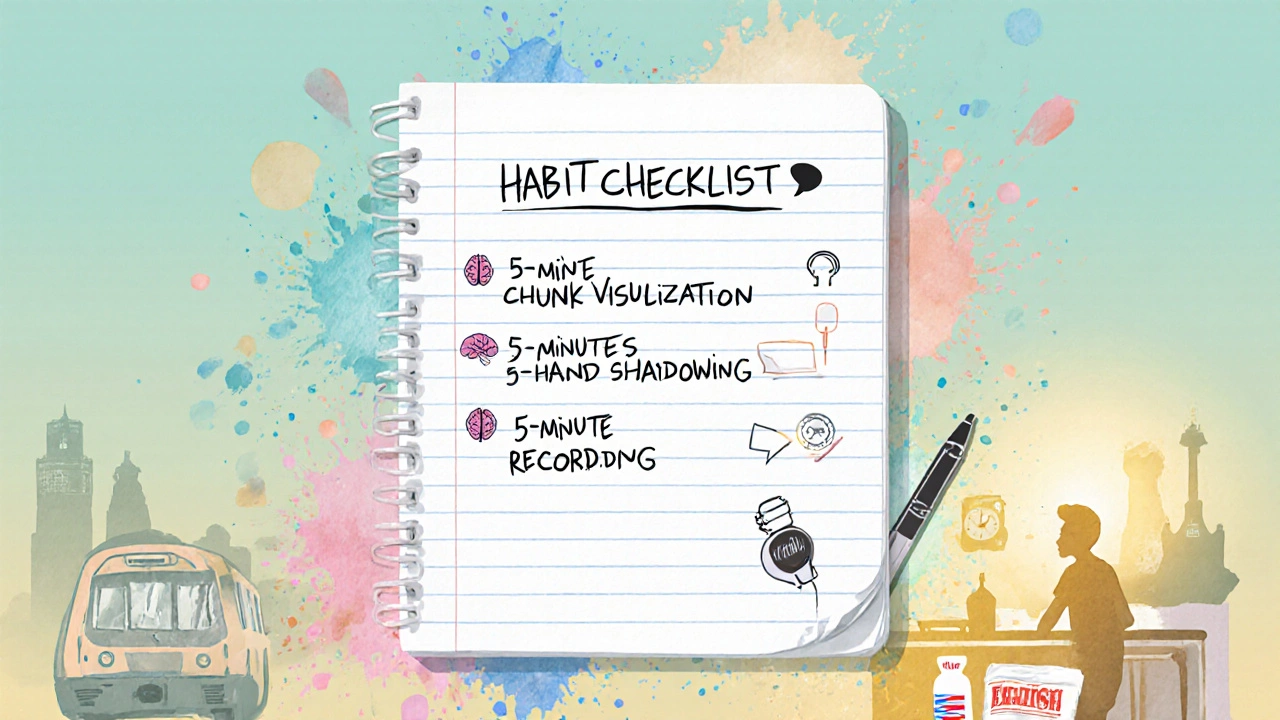Confidence Plan Generator
Your Personalized Plan
Create your daily 15-minute confidence-building routine
Your Daily Practice Plan
Practice one chunked sentence with your visual cue
"Bridging the gap" - imagine a golden bridge connecting two sides
Shadow a 30-second news clip
Start with slow news, then increase speed
Record a 30-second response to this prompt:
Progress Tracking
Rate your confidence daily (1-5):
Ever caught yourself freezing the moment you need to speak English confidently? It’s not just nerves - your brain plays a huge role in how fluid and assured you sound. The good news? You can rewire those mental habits with targeted training, just like a muscle.
Why the Brain Matters for Speaking Confidence
When we talk about brain training is the set of mental exercises that sharpen neural pathways involved in language production, memory, and anxiety regulation. In simple terms, the more your brain practices speaking, the less it treats English as a foreign threat and the more it sees it as a familiar skill.
Adopt a Growth Mindset
The first mental upgrade is shifting from a fixed view - "I’m bad at English" - to a growth perspective - "I can improve with effort". This mindset confidence acts as a catalyst, encouraging you to take risks and learn from mistakes rather than avoid them. Research from the University of Chicago (2023) shows learners with a growth mindset make 30% more speaking attempts in a 4‑week period.
Deliberate Practice: Quality Beats Quantity
Deliberate practice is a focused rehearsal method where you isolate weak spots, receive immediate feedback, and repeat until the skill feels automatic. Instead of chatting about anything, pick a specific grammar point or pronunciation trouble, record yourself, and correct the errors on the spot.

Speech Shadowing - Mirror a Native Speaker
One of the fastest ways to train your speech muscles is speech shadowing, which means listening to a short audio clip and speaking the exact words at the same speed, matching intonation and rhythm. Start with 30‑second news bites, then gradually increase length. Over time, your brain internalizes natural cadence, and confidence follows.
Chunking and Visualization
Our brains love patterns. Chunking breaks long sentences into bite‑size phrases that are easier to recall. Pair each chunk with a vivid mental picture - for example, imagine a "golden bridge" when practicing the phrase "bridging the gap". This visual cue reduces retrieval anxiety.
Create an Immersive Language Environment
Surround yourself with English so the brain receives constant low‑level input. Language immersion doesn’t have to mean moving abroad; it can be as simple as setting your phone to English, listening to English podcasts during commute, and labeling household items with their English names. Consistent exposure trains the brain to think in English rather than translate.
Daily Habit Checklist - 15 Minutes to Confidence
- 5 minutes: Review one chunked sentence and visualize the associated image.
- 5 minutes: Shadow a short audio clip (news, podcast, or YouTube excerpt).
- 5 minutes: Record a 30‑second response to a prompt, then replay and spot one improvement.
Stick to this routine for three weeks and you’ll notice smoother flow and lower anxiety.

Common Pitfalls & How to Dodge Them
Skipping feedback. Recording without listening back reinforces mistakes.
Over‑relying on subtitles. They become a crutch; aim to watch with subtitles off after the first pass.
All‑or‑nothing mindset. Missing a day doesn’t mean failure - treat each session as a micro‑step toward confidence.
Technique Comparison
| Technique | Primary Focus | Time Needed per Day | Key Benefit |
|---|---|---|---|
| Deliberate Practice | Targeted error correction | 10‑15min | Fast improvement on weak spots |
| Speech Shadowing | Pronunciation & rhythm | 5‑10min | Natural intonation, reduced accent |
| Chunking & Visualization | Memory retrieval | 5min | Less hesitation, smoother flow |
| Language Immersion | Passive exposure | Varies (integrated) | Think in English, fewer translations |
Next Steps: Build Your Personal Confidence Plan
Pick the technique that feels least intimidating and schedule the 15‑minute habit. Track your daily effort in a simple notebook - note the sentence you shadowed, the chunk you visualized, and a quick self‑rating (1‑5) of confidence. After two weeks, review the ratings; you’ll see a steady climb.
Frequently Asked Questions
Can I become fluent without living in an English‑speaking country?
Yes. Consistent immersion, deliberate practice, and shadowing can simulate many of the benefits of being abroad. The key is to create daily touchpoints that force your brain to think in English.
How long does it take to feel confident speaking?
Results vary, but most learners notice reduced anxiety after 3‑4 weeks of focused 15‑minute practice. Significant fluency gains usually appear after 2‑3 months of sustained effort.
Should I focus on grammar first or speaking?
Both are intertwined. Use grammar as a tool for clear expression, but practice speaking from day one. Short, grammar‑light sentences help keep the flow while you build confidence.
Is recording myself embarrassing?
It feels odd at first, but recording gives you objective data. Listen without judgment, note one specific improvement, and celebrate each tiny win.
What if I miss a day?
Missing a single session isn’t catastrophic. Treat it as a reset, not a failure. The habit grows stronger the more consistently you return.
